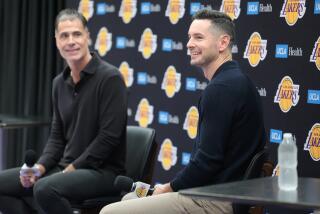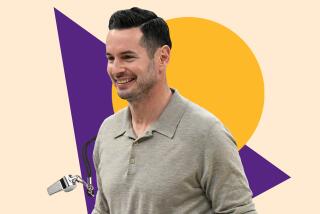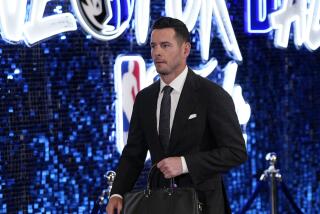If He Manages as He Played, Baylor Will Make the Right Moves
- Share via
A few years ago I was involved in an automobile accident. My car was knocked up onto the sidewalk and into a storefront. Glass flew everywhere. I didn’t know who or what had hit me.
Legs shaking like a rookie’s on opening day, I stepped from my battered car. Out of the gathering crowd came an excited little man wearing a baseball cap and black, high-top gym shoes. I thought he was concerned about my possible injuries but he nervously asked: “What ever happened to Elgin Baylor?”
The gentleman’s timing left a lot to be desired, but he had a legitimate question. Why, indeed, was the player who many contend that, pound for pound, was the greatest ever to grace a pro basketball court, no longer associated with the game?
That’s not a question today. Baylor is back, having been hired Tuesday as the Clippers’ director of basketball operations. If he’s anywhere near as successful in the front office as he was on the court, the Clippers should be dynamite any day now.
Let’s reminisce a little: Old Capt. 22, everyone’s Hall of Famer, Elgin Baylor gave the Minneapolis and the Los Angeles Lakers 12 superstar seasons between 1958 and 1970. For the young among us who never got a chance to see Elgin play, he was simply awesome. By 1970, though, his knees were worn out. A knee injury kept him out of all but two games in his 13th season, and he retired nine games into his 14th.
Baylor, a living legend at Spingarn High School in Washington, D.C., chose to continue his education at the College of Idaho in Caldwell, Ida. He enrolled there on a football scholarship because the school had used all of its basketball scholarship money.
When Baylor’s basketball talents were seen in a pickup game with R.C. Owens, a fellow scholarship athlete and future star wide receiver in the National Football League, the coaches agreed that Baylor’s court expertise would never be jeopardized on the gridiron.
Baylor played one stellar season for the folks in Idaho, averaging 31 points a game. He then transferred to Seattle University, where in two years of All-American play--he sat out a season after transferring and was drafted by the Lakers as a junior eligible--he averaged 31 points a game, led the NCAA in rebounding and in his junior season took his team to the Final Four.
Baylor’s basketball proficiency has seldom been described as anything less than incredible. Even his teammates shook their heads in disbelief. He was the original human highlight film, doing things on the court that defied gravity and exceeded even his own expectations.
In top shape, Baylor stood 6 feet 5 inches and weighed 230 power-packed pounds. He had the grace of an antelope, the strength of a middle linebacker, the touch of a diamond cutter and jumping ability that allowed him the longest hang time in basketball. As a front-line passer he had no peer. He rebounded with the best, including the legendary Bill Russell and Wilt Chamberlain.
From time to time, Baylor brought the ball up the court from the guard position, displaying ballhandling skills superior to many backcourt players.
In short, he did it all. But it was Baylor the improviser who brought the crowds to their feet. He was the Stan Kenton of pro basketball. Elgin dramatically performed creative moves that no one had ever seen before. He was a thinking man’s player with the magical soaring ability of Peter Pan.
As a 6-5 power forward, Baylor had a career scoring average of 35.7 points. In 1960, the team’s first year on the West Coast, he astounded Los Angeles fans by scoring 34.8 an outing. His second year in Los Angeles was the best of his pro career. He averaged 38.3 during the 1961-62 season.
Fans still talk about Baylor’s single-game playoff scoring record of 61 points against the Boston Celtics in 1962. And who will forget the 71 points he scored against the New York Knicks at old Madison Square Garden back in ‘63?
With his teammates, Baylor was gregarious and outgoing. We called him motor mouth. Away from the court, the locker room and the people with whom he was most comfortable, however, Baylor was often quiet and reserved, which was sometimes misread as cold indifference. But Baylor was neither cold nor indifferent.
Career’s end came for Baylor when he retired Nov. 5, 1971, at the start of the season that resulted in Bill Sharman’s Lakers beating the New York Knicks for the NBA title.
One of the saddest scenes I’ve witnessed in sports occurred at the Forum the evening of May 7, 1972. The Forum was alive with jubilant fans celebrating the Lakers’ championship, and in the team’s locker room, the champagne and beer flowed. I watched the recently retired Baylor go around and congratulate all of his former teammates.
He was happy for them, but you could see that not having been an active part of it all was ripping him apart. Seven times Baylor had led the Lakers into the championship finals against Boston, but he never got the chance to keep Red Auerbach from lighting up his victory cigar.
In 1974, the NBA’s New Orleans Jazz hired Baylor as an assistant to Bill van Breda Kolff. When the Jazz fired van Breda Kolff, Elgin took over as head coach, but his 2 1/2-year stint there was a losing experience.
The Jazz, with the likes of Pete Maravich, Otto Moore, Rich Kelly, Gail Goodrich, Bud Stallworth and Truck Robinson, just couldn’t cut it. Baylor was fired in 1979 and the team was later moved to Salt Lake City.
Until Tuesday, Baylor had tried unsuccessfully to land a local NBA front-office job, but there was nothing cooking for him. He once questioned the Lakers’ willingness to name a black ex-player to the front-office staff and came within a signature of getting a desired position.
That was after Laker Coach Jack McKinney had suffered severe head injuries in a bicycle accident and was replaced by Paul Westhead, his assistant and friend. Pat Riley then Chick Hearn’s sidekick, gave up the microphone to become Westhead’s assistant, and Baylor was about to join the fold.
According to Baylor, owner Jerry Buss had his lawyer draw up a multiyear agreement that called for an annual salary of $60,000. Baylor and his legal adviser eagerly awaited the contract, but after three weeks they were told that Buss was no longer interested.
Perhaps Elgin could have gotten another front-office job sooner had he been willing to relocate, but he wasn’t.
But now, Los Angeles’ first NBA superstar, the great Elgin Baylor, the leading force in convincing Southern California that pro basketball and the Lakers were worth supporting, is at it again.
Fittingly, perhaps, the locale will be the same--the Los Angeles Memorial Sports Arena where Baylor first worked his magic for West Coast fans 26 years ago. Now, though, he will have to do it from the front office while promoting the Clippers red, white and blue. Once again, he has his work cut out for him.
More to Read
Go beyond the scoreboard
Get the latest on L.A.'s teams in the daily Sports Report newsletter.
You may occasionally receive promotional content from the Los Angeles Times.






